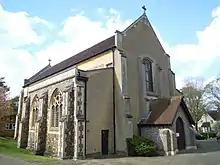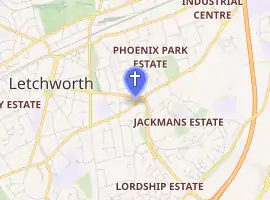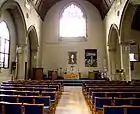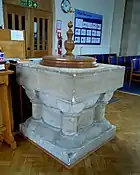Church of St Paul, Letchworth
The Church of St Paul in Letchworth in Hertfordshire is the Anglican parish church for the Letchworth Gate area of the town at the top of Pixmore Way. Dating from 1924, with later extensions, it is a 'daughter church' of the nearby Church of All Saints in Willian and comes under the Diocese of St Albans.[1] Built as a 'Victory' church following World War I, the building is the largest war memorial in Hertfordshire.
| Church of St Paul | |
|---|---|
 The Church of St Paul in Letchworth in 2017 | |

| |
| 51.97495°N 0.21617°W | |
| Location | Letchworth, Hertfordshire |
| Country | England |
| Denomination | Anglican |
| Website | www |
| History | |
| Status | Parish church |
| Consecrated | 3 May 1924 |
| Architecture | |
| Functional status | Active |
| Architect(s) | Arthur Heron Ryan Tenison |
| Groundbreaking | 10 October 1923 |
| Administration | |
| Diocese | St Albans |
History



When Ebenezer Howard set up his first garden city in Letchworth in 1903 the Church of England gave little thought as to the spiritual needs of the citizens of the new town by building a central Anglican place of worship. The site being developed by Howard's First Garden City Ltd. crossed the parish boundaries of three local ancient village churches: St Mary's church, St Nicholas, Norton, and All Saints, Willian. When in 1917 the Revd Montagu Sharpin Swatman was appointed to the living of Willian he decided to set up a church in Letchworth's Pixmore area in the expectation of building a permanent building when funds became available.[2]
Swatman called a meeting in November 1918 to discuss building a permanent church which was attended by 28 people who donated £29 5s. In 1919 he set up a hutted church on a piece of land bought from the First Garden City Company by the Diocese of St Albans. Swatman now had a site on which to build a 'Victory Church' as a memorial of the victory at the end of World War I. The architect Arthur Heron Ryan Tenison (1861-1930) was commissioned[3] to produce a design described by Nikolaus Pevsner as "an ambitious project... A conventional Decorated Gothic style was adopted with flint walls and stone dressings with conventional gothic traceried windows." Tenison's design for the church was accepted for exhibition at the Royal Academy of Arts in 1921. A Garden City 'Victory' Church Appeal was launched in 1921 which by October had raised £2,000. At this time it was decided that the new church would be called St Paul's.[4]
Eventually, through a variety of fund-raising activities £5,000 was raised to allow construction of the new church to begin, with the foundation stone being laid on 10 October 1923 by the Marchioness of Salisbury. Work on the first section of the building was completed including three and a half bays of the nave with arcades at the sides. This first section was consecrated by Michael Furse, the Bishop of St Albans on 3 May 1924.[5] A tower was intended but was never built.[3]

By 1924 the church was becoming too small for its growing congregation and work on an extension began in early 1931, with two further bays being added to the nave and adding two single bays on both sides, that on the south to house the organ and that on the north to act as a vestry, with a temporary wall being added in the east. This extension was dedicated on 18 December 1931.[6] The baptismal font was found in pieces in a builder's yard in 1934 having been removed from St Albans Abbey, where it had been installed in 1853. The font was obtained for the price of transporting it to St Paul's where it was installed and dedicated to the memory of the late Mrs Evelyn Swatman.[7]
By 1938 the church needed to be extended again, and an appeal was launched to raise the required £1,000; this sum was reached by 1940 and the north aisle was finished, a vestibule built and the roofing of the nave completed. In 1958 a Church Hall was built, and in 1963 St Paul's became a separate parish from Willian. In 1989 the church was reordered, turning the seating around from facing the east to facing the west. At about the same time a new smaller altar was installed and new communion rails fitted. The pulpit was boarded in and the baptismal font moved to the northeast corner of the church.
In August 2015 windows at the church and those at St Mary's church in Hitchin were smashed in what police called a "religiously motivated attack." Christopher Battison, aged 38, from Letchworth, was charged with the attack.[8][9][10][11]
References
- St Pauls', Letchworth on the Church of England website
- Harkness, Peter, The Story of St Pauls's, Letchworth: The First Seventy Years 1923-1998, Osprey Print Services (1998) p. 3
- Nikolaus Pevsner (revised by Bridget Cherry) (2002). The Buildings of England: Hertfordshire. Yale University Press. p. 229. ISBN 0300096119 – via Google Books.
- Harkness, p. 5
- Harkness, p. 6
- Harkness, p. 9
- Harkness, p. 43
- "Religious hate crime' at Hitchin church damages cherished First World War memorial – and Letchworth targeted too" - The Comet - 27 August 2015
- "Arrest made after Hitchin and Letchworth GC churches fall victim to criminal damage" Archived 2015-09-14 at the Wayback Machine - Hertfordshire Mercury - 28 August 2015
- "Man charged with criminal damage after attacks on churches in Hitchin and Letchworth" Archived 2015-09-26 at the Wayback Machine - Hertfordshire Mercury - 24 September 2015
- "Man charged in connection with criminal damages in Hitchin and Letchworth" Archived 2017-04-12 at the Wayback Machine - Hertfordshire Constabulary website - 25 September 2015
External links
| Wikimedia Commons has media related to Church of St Paul, Letchworth. |
- Church of St Paul, Letchworth Parish Website
- St Paul's, Letchworth on the Letchworth Heritage Foundation website
- St Paul's on the Hertfordshire Churches in Photographs website